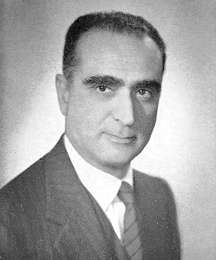Luigi Barzini, Jr.
| The Honourable Luigi Barzini, Jr. | |
|---|---|
 Luigi Barzini, Jr. in 1962. | |
| Member of the Italian Chamber of Deputies | |
|
In office 12 June 1958 – 24 May 1972 | |
| Constituency | Milan |
| Personal details | |
| Born |
21 December 1908 Milan, Italy |
| Died |
30 March 1984 (aged 75) Rome, Italy |
| Nationality | Italian |
| Political party | Italian Liberal Party |
| Spouse(s) |
Giannalisa Feltrinelli (m. 1940–47); divorced Paola Gadola (m. 1950–84); his death |
| Children |
Ludina (1942–) Benedetta (1943–) Luigi III (1951–) Andrea (1952–) Francesca (1953–) |
| Parents | Luigi Barzini, Sr. and Emma Pesavento |
| Profession | Journalist, publisher, writer |
| Religion | Catholic Church |
Luigi Barzini, Jr. (Milan, 21 December 1908 – Rome, 30 March 1984) was an Italian journalist, writer and politician most famous for his 1964 book The Italians, delving deeply into the Italian national character and introducing many Anglo-Saxon readers to Italian life and culture.[1]
Early life
Barzini junior was born in Milan, Lombardy, the son of Luigi Barzini, Sr., a famous journalist. In the 1920s, his father left the Corriere della Sera and moved to the United States, where he directed the Italian-American newspaper Corriere d'America from 1923 to 1931.[1]
After completing his studies in Italy and at Columbia University, Barzini Jr. worked for two New York newspapers, including the New York World.[1] In 1928, together with Richard Washburn Child, former Ambassador to Italy and a supporter of Benito Mussolini, he ghostwrote The Autobiography of Benito Mussolini.[2] He returned to Italy in 1930 to become a correspondent for Corriere della Sera.[1]
His father had pro-Fascist sentiments and had access to highest political circles of Benito Mussolini's Fascist regime. Luigi Jr., however, frequently associated with young dissidents around Galeazzo Ciano, the Italian Minister of Foreign Affairs and Mussolini's son-in-law.[1]
Panay Incident
As the Corriere della Sera Asian correspondent, he went to China. On 11 December 1937, he was aboard the USS Panay on the Yangtze Patrol in Nanking at the prompting of George Atcheson, a U.S. Embassy official. Also aboard were Universal News cameraman Norman Alley, Movietone News' Eric Mayell, the New York Times's Norman Soong, Collier's Weekly correspondent Jim Marshall, and La Stampa correspondent Sandro Sandri. Atcheson had invited them aboard the Panay so that they could document the fall of the city from relative safety. The four journalists had been covering the ongoing Japanese invasion of China in the mid-1930s, and found themselves in the thick of things in early December 1937 as Japanese forces moved on Nanking.[3]
According to Alley, writing in his memoir I Witness, Atcheson proclaimed that aboard the gunboat the group would be "as safe as you would be on good old American soil." Little did any of them know that in just a week's time, the Panay would be attacked and sunk, Sandri killed, and that they would witness the Rape of Nanking.
During the attack Barzini, although wounded, performed heroically helping to bring the wounded ashore and providing first aid to the best of his ability. As Sandri, known as "the Floyd Gibbons of Italy,"[3] was stretched out in the reeds with excruciatingly painful, fatal stomach wounds, Barzini could only comfort him with an occasional cigarette and a word from time to time. This episode of the incident was captured on Alley's and Mayell's cameras and in a 1937 Wide World Photos shot titled "Consoling dying Panay victim".
Banned by the Fascists
In April 1940, he was arrested on charges of leaking confidential information to the enemy and making disparaging remarks about Mussolini.[1] He was confined by the Fascists to forced residence in a village for five years, but in 1944, when Rome was liberated, he resumed his journalistic career, as editor-in-chief of daily and weekly publications. He founded Il Globo. Subsequently he served in turn as the chief editor of several newspapers and magazines.
A staunch anti-Communist, he was a member of the Italian Chamber of Deputies from 1958 to 1972, for the centre-right Italian Liberal Party (Partito Liberale Italiano – PLI).[1]
He was the father of five children, and lived on a small farm near Rome, where he produced his own olive oil, wine, vegetables, and fruit. Barzini died in 1984 of cancer at his home in Rome.[4] His daughter Benedetta, by his second wife Paola Gadola Feltrinelli, was a successful fashion model during the 1960s.[5]
Works
- Americans are Alone in the World (1953)[6]
- The Italians: A Full Length Portrait (1964)[7]
- From Caesar to the Mafia (1971)
- O America When You and I were Young (1977)
- The Europeans (1983)
References
- 1 2 3 4 5 6 7 Sarti, Italy: a reference guide from the Renaissance to the present, p. 142
- ↑ D'Agostino, Rome in America, pp. 163–64
- 1 2 Suddenly and Deliberately Attacked! The Story of the Panay Incident, The USS Panay Memorial Website (Accessed 17 October 2010)
- ↑ Luigi Barzini, Italian Author, Dies At 75 In Rome, Obituary, The New York Times, 1 April 1984
- ↑ Once a 'Vogue' Star, Benedetta Barzini Is Now Fashion's La Pasionaria, People Magazine, Vol.8, No. 2, 11 July 1977
- ↑ These Strange Americans, Time, 26 October 1953
- ↑ Reflections on the Italians, Time, 25 September 1964
- D'Agostino, Peter R. (2004). Rome in America. Transnational Catholic Ideology from the Risorgimento to Fascism, Chapell Hill (NC): University of North Carolina Press, ISBN 0-8078-5515-4
- Sarti, Roland (ed.) (2004). Italy: a reference guide from the Renaissance to the present, Infobase Publishing, ISBN 0-8160-4522-4